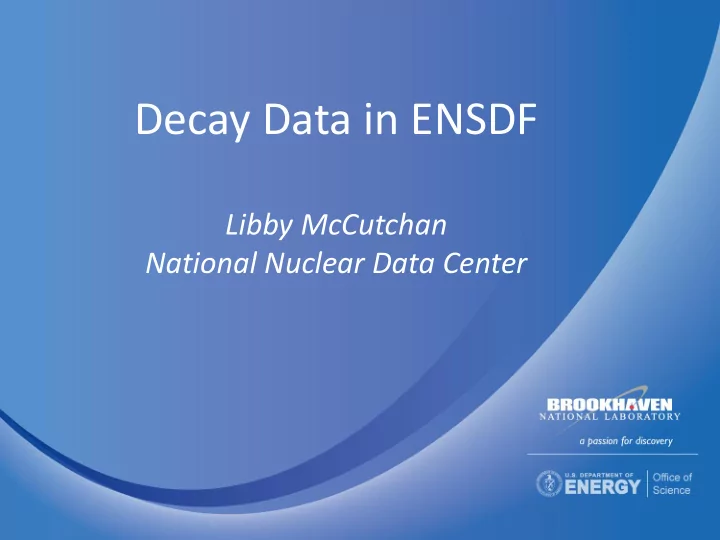

Decay Data in ENSDF Libby McCutchan National Nuclear Data Center
Reference Material
Get your calculators ready Today will be less talking and more working through examples Will focus on beta decay and IT decay, since alpha decay has hopefully been well covered in A=218 evaluation work
Go with the flow What goes in must come out 100 100
Relevant Quantities Needed to Deduce NR – relative photon intensity to photons / 100 decays NT – relative transition intensity to transitions / 100 decays Above are through the particular decay branch BR – Convert intensity / 100 decay through this decay branch to intensity per 100 decays of the parent NB – relative beta and ec intensities to intensities per 100 decays through this decay branch NP – convert per 100 delayed transition intensities to per 100 decays of the precursor
Decay Scheme Normalization Quantities NB NP NR NT BR Relative Intensity Normalization Factor Absolute Intensity I =%I x NR x BR I (tot) x NT x BR =%I (tot) I (or or ) x = % I (or or ) NB x BR I n (or I p) x = % I n (or I p) NP Beta and ec are usually given as per 100 parent decays. Since NBxBR, NB=1/BR
The definitions
My advice • There is good documentation on how to normalize decay schemes … but information on how that translates in use of NR, BR, NB, etc is lacking • Particle decays are very tricky… take care and always check processed output • Read the policies and go back and read again
Times have changed From earlier ENSDF talk on decay
The Future # of ions counted individually
But a Careful Review is Still Required 1 BR= 1 NR= For excited levels: I = I( +ce)(out)- I( +ce)(in) 15(3) 5(2) 8(3) For ground state : 20(4) I =100- I( +ce)(gs) 8(3) 14(2) 14(2)-15(3) = -1 (4) <3 6(2) 6(2)-5(2) = 1 (3) <4 100 – 6(2) – 14(2) – 8(3) = 72 (5)
B- and B-N Example B-N branch Absolute Intensity B- branch 1348 = 28.4(10) %
The easy B- branch Absolute Intensity 1348 = 28.4(10) % NR= 0.284 (10) BR= 1.0 Beta feedings are 6.7*0.284 = 1.9 2.3*0.284 = 0.65 1.5*0.284 = 0.42 GS feeding: Here you need to consider B-N branch 100-Pn- I( +ce)(gs): 100-62.8-1.9-0.65-0.42 <34
Absolute Intensity of 1348 = 28.4(10) % NR= 0.284 ? 0.628 ? BR=
The details This is Pn BR=0.628 28.4 is I per 100 decays Through the decay branch, you need : 0.284/0.628 = 0.425 NR=0.425
How to define NP? Example of B-N and B-2N Decay
Start with the “easy” beta -decay Intensities are again given as Absolute Ig / 100 decays NR = 1 BR = 1 Keeping in mind that Pn=33% and P2n=12% GS Beta Feeding is 100-Pn-P2n- I (to gs) 100-33-12-24 < 32
The B-N Branch
Branching ratio is given BR=0.33 3 Neutron and Gamma Intensities given in absolute units What is NR ? NR=1.0
The details This is Pn BR=0.33 I is given per 100 decays Through the decay branch, you need : NR = 1.0/0.33 NR=3.03
Branching ratio is given BR=0.33 3 Neutron and Gamma Intensities given in absolute units What is NP? NP=3.03
The details Relative Intensity Normalization Factor Absolute Intensity I =%I x NR x BR I (tot) x NT x BR =%I (tot) I (or or ) x = % I (or or ) NB x BR I n (or I p) x = % I n (or I p) NP Particle decays are treated differently NP=1
Finally the B-2N Branch 1 0.12 NR = ? BR = ? 0.12 1.0 NP = ?
Use of Annihilation Radiation I( ) = relative annihilation radiation intensity X i = intensity imbalance at the ith level We want to isolate + feeding the i X i = i + i + + (1+r i ) X i = i + = X i / (1+r i ) i r i = i / i + (theoretical)
Use of Annihilation Radiation r i = i / i + (theoretical) How many do we expect? + ] I( ) = 2*[ o + + i I( ) = 2* [ X o /(1+r o ) + X i /(1+r i ) ] 7.5/(1+0.068/1.8) = 7.23 I( ) = 795 (80) 8.3/(1+0.071/2.0) = 8.02 (100-6.0-7.5)/(1+0.44/21.2) = 84.7 7.2+8.0+84.7 = 99.9
Use of Annihilation Radiation Solve for X o 99.9 I( ) = 2 [ X o /(1+r o ) + X i /(1+r i ) ] X o /(1+r o ) = (795/2) – 99.9 = 297.6 X o = 297.6*(1+[1.01/73]) = 301.8 I( ) = 795 (80) (X o + I( +ce)(to gs))*N = 100 (301.8+100)*N = 100 N = 0.25
IT Decay Normalization Usually easy, since whatever comes out of the isomer has to reach the g.s. Many options: I( +ce) values I( +ce)(to gs) = 100 N=100/(3.4+0.47) = 25.8 I( +ce)(out 199) = 100 N=100/(2.7+1.8) = 22.2 I( +ce)(out 148) = 100 What’s N? N=100/(4.2+0.47) = 21.4 Does it matter if not balanced?
Energy released in beta decay Q Electromagnetic (EM) = I E + I x-ray E x-ray Light Particle (LP)= I - E - + I ce E ce + I Auger E Auger Total Energy=EM+LP+E neutrino = Q( -)
RADLIST Program to analyze decay radiation (radiation list) Few options • Calculate energy release for each radiation type • Generate ENDF file • Generate NuDat file • Generate MIRD output
RADLIST Output from the program directly
RADLIST Output from the EVP editor
Recommend
More recommend